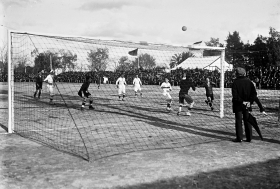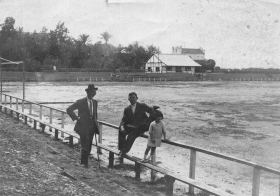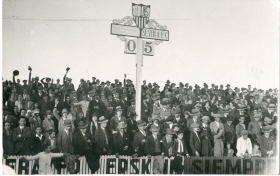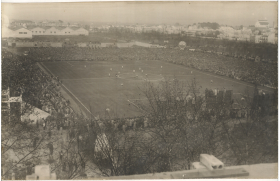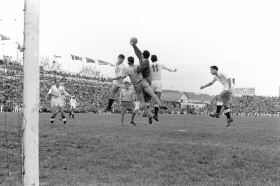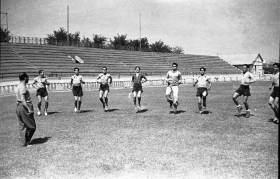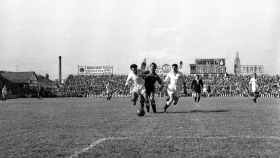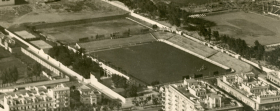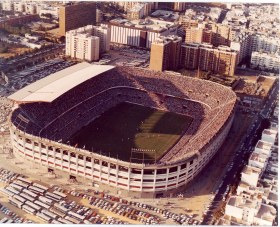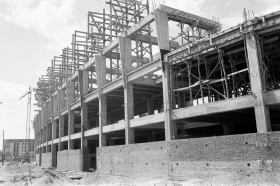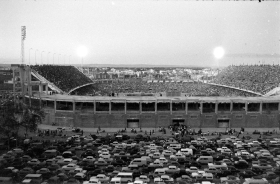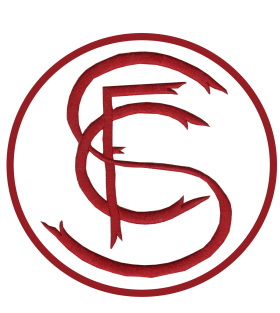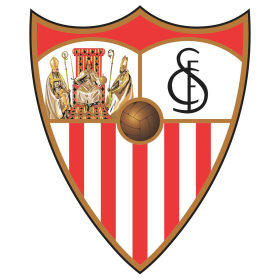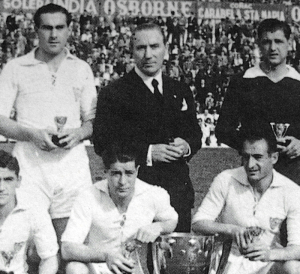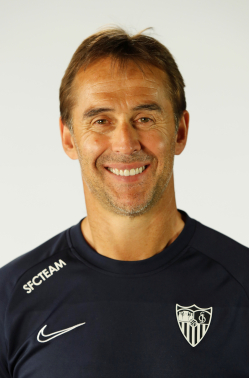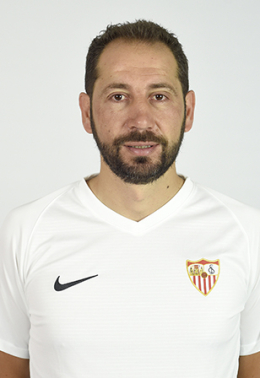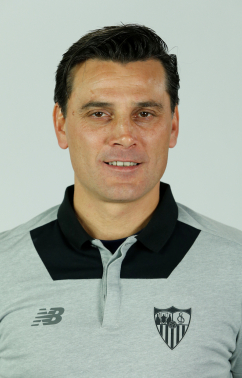In 1918, due to the redevelopment work that Sevilla City Council had to carry out in Prado de San Sebastián for the future Ibero-American Exhibition, both Sevilla FC and the rest of Sevilla's clubs were forced to abandon their grounds there.
Sevilla FC were forced to look for a new site, and to do so, set up a committee made up of several members of the board of directors, who visited the mayor of the city in an attempt to obtain a municipal plot of land for the club, but the negotiations proved unsuccessful. After this, various sites were considered, including a plot of land in Nervión, just where the old slaughterhouse was located, which is now the Delegation of Education of the Andalusian Regional Government, although in the end a large plot of land on Avenida de la Reina Victoria, now Avenida de La Palmera, was chosen.
The so-called "Campo de Sport del Sevilla FC de la Avenida de la Reina Victoria" was inaugurated on 21 October 1918.It was built after an agreement was reached between President Paco Alba - and the aforementioned commission - and the Marquise of Esquivel, María del Pilar de Carvajal Hurtado de Mendoza, to lease part of the land she owned on the estate known as Casablanca, located at the foot of the Paseo de la Palmera. The son of the Marquise, who was a great football fan and a great Sevillista, managed to convince his mother not to make the rent too expensive, setting an annual amount of 2,000 pesetas. For the second time in its history, the club built its stadium with its own funds. To finance the stadium, the club put 100 bonds up for sale, at a price of 100 pesetas each, to be repaid over five years.
The costs of the construction of the stadium were distributed among different items. 1,350 pesetas for the fencing (dismantling of the fence of the previous Mercantil pitch and its subsequent assembly in the new location) and the levelling of the pitch, work carried out by Manuel Domínguez. In addition, the carpenter José Grosso Barba surrounded the pitch with wooden benches and built a small grandstand 10 metres long, as well as four stands for seating at a price of 6.75 pesetas per square metre.
Finally, a stand was built for 3,000 pesetas, designed and executed by the architect Pablo Gutiérrez.
The hut was used as a changing room and as a house for the groundsman, initially occupied by Eduardo Santizo, father of the player of the same name, and later by Manuel Pérez, El Terrible, a former player of the Club and the first of the Pérez family, so closely linked to Sevilla FC up to the present day. But the hut was not only the groundsman and dressing room, as part of it was also used as a room for the club's medical service, something new at the time, which was taken care of by Dr. Puelles de los Santos. For the first time in the history of stadia in Sevilla, the changing rooms housed a shower.
"...The pitch has undergone some good renovations this year. Pérez has definitively stayed on as groudnsman and will live in the new clubhouse that has been built out of material, at the back of which a room has been made for him to live in with his wife and children.
The room he had before will be used as an infirmary and the same massage apparatus will be installed. The doctor is Mr. José Puelles de los Santos. The first team players have their room with 15 hangers for their equipment and their shower and washbasin (...) The other room is for the board of directors..." (Letter from the club secretary Manuel Zapata to the player Ismael Rubio).
The pitch was equipped with all the necessary elements for the good practice of football. It had stands on all four sides of the ground, and was completely enclosed.
The inauguration took place with a match between Sevilla FC and Unión Sporting Club de Madrid. The first season the following prices were established for the public: Grandstand: 1st row 10 pesetas, 2nd row 9 pesetas, 3rd row 8 pesetas, Row of benches 5 pesetas. The membership fee went up from 2 to 3 pesetas a month.
In 1924, the president Manuel Blasco Garzón carried out another reform, placing two new side stands with new access embankments and achieving a capacity of more than twelve thousand seats.
This stadium achieved great fame, because it was here that Sevilla FC demonstrated its supremacy in Andalusian football, winning up to nine Andalusian Championships. The first match of the Spanish National Team in Andalusia was played here on 16 December 1923, against Portugal, where Spain won 3-0, also producing the international debut of the first two Sevilla players: Spencer and Herminio. On 10 May 1925, it hosted the final of the Spanish Championship between FC Barcelona and Arenas de Guecho.
In 1926 the lease period expired and a moratorium of two more years was reached. During this time, Sevilla FC had up to three fronts open for the acquisition of a new stadium. One of them was in the area of the planned Los Remedios neighbourhood, but it was not carried out due to the refusal of the Ibero-American Exhibition Committee to provide the necessary subsidies to the construction company of Mr. and Mrs. Goizueta. This was due to the fact that the aforementioned committee intended to build the Stadium - as was the case - in the southern sector of the city. The acquisition of some land owned by Genaro Parladé in front of the field on Avenida Reina Victoria was also negotiated, but this did not come to fruition as no economic agreement was reached. Finally, the offer made by the Exhibition Committee itself for Sevilla to take over the operation of the aforementioned Stadium after the Ibero-American Exhibition was studied. Talks in the latter case were held until months before the decision to move to Nervión in 1928.
In 1928, under the presidency of Juan Domínguez Orborne, Baron de Gracia Real, a 14,300 square metre plot of land belonging to the Nervión real estate company was leased to Pablo Armero, Marquis of Nervión, where the Nervión Stadium was to be built. To pay the rent for the land and the construction of the stadium, a certain number of bonds were issued at a price of five pesetas. The debentures were issued on 15 July 1928. The maturity date for the annual draw of 2,000 bonds was 31 July 1929 and the following years until ten years were completed. During the season the holders of these shares could exchange them for preferential tickets, although they forfeited the interest which was set at 5% per annum.
Renting this plot of land was really expensive and the construction of the stadium itself was much more costly. In the minutes of a board of directors meeting in March 1928, we read that the Marquis of Nervion offered a plot of land some 600 metres from the San Bernardo Bridge, under the following conditions: annual rent of 5,000 pesetas and construction of the pitch (fencing and stands) for 100,000 pesetas to be paid over ten years.
The truth is that not many bonds were sold and the president had to advance a large amount of money to carry out that great work, money that the president paid back in easy instalments that he collected after the matches were played. Sometimes he received 2,000 pesetas, sometimes 3,500 pesetas, and so on until the total of the money advanced was reached. The manager in charge of the treasury set aside the usual expenses for the match schedule and the surplus was divided into two parts, one to pay the players and coach and the other to reduce the debt contracted with the Baron of Gracia Real.
The Nervión Stadium was built on this land and was inaugurated on 7 October 1928 in a match against Real Betis Balompié.
Its capacity was initially 12,000 seats. Later it was increased to 20,000 seats and in special circumstances such as European Cup matches or matches against big rivals, the stadium could hold up to 27,000 seats.
A key date for this stadium is 29 April 1938, when, as President of Sevilla, Ramón Sánchez-Pizjuán signed the deeds for the purchase of the land occupied by the stadium. Sevilla acquired not only the land where the Nervión stadium was located, but also 42,000 m2 more in the surrounding area for the construction of a new stadium and the construction of other facilities for the practice of other sports. In addition to the main pitch, besides the dressing room and the snack bar, a training pitch (also known as the Subcommittee pitch), two tennis courts and a pelota court were also built. The 14,300 m2 occupied by the Nervión Stadium were bought at a price of seven pesetas per square metre, the 42,000 adjacent at a price of nine pesetas per square metre.
The amount of the purchase was 429,000 pesetas. In order to cover this purchase, new bonds were issued at a price of 500 pesetas.
The Nervión Stadium will always be remembered for the great successes that Sevilla FC achieved there. A League Championship and three Spanish Cups, as well as six Andalusian Cups and Sevilla's first participation in the European Cup, today the Champions League.
The Nervión Stadium also hosted a Spanish national team match on 15 March 1942, with the result Spain 4-0 France.
After 30 years, Viejo Nervión was starting to become too small and outdated. The new demands of football required comforts and capacities that the old stadium could not satisfy. That is why the Ramón Sánchez-Pizjuán Stadium was inaugurated on 7th September 1958, in a match against Real Jaén that ended in a three-goal draw. The new stadium was located next to the grounds of the old one.
The idea of building the new stadium was first mooted in November 1937, when Ramón Sánchez-Pizjuán negotiated with Pablo Armero the purchase of the Nervión stadium and an annex of 42,000 square metres, where the new stadium was to be built.
The project for this new stadium dates back to 1954. In January of that year, Sevilla FC organised a competition for ideas for the construction of a new stadium with a capacity of at least 50,000 spectators.
The competition was won by the architect Manuel Muñoz Monasterio, who had years earlier built the Santiago Bernabéu and Mestalla, and who was about to begin construction of the Ramón de Carranza in Cádiz. Thus, the architect from Madrid obtained the prize of 50,000 pesetas, the amount that the winning sketch was endowed with, and also received the commission for the final project.
The approved project consisted of a stadium with a capacity for 70,329 spectators, 20,329 seated and 50,000 standing, with the standing areas behind both goals and also in the upper tier of the Fondo Stand.
The sudden death of President Sánchez-Pizjuán, on 28 October 1956, prevented him from seeing his lifelong dream come true, but the Presidents who succeeded him, especially Ramón de Carranza and Gómez-Pablos, Marquis of Soto Hermoso, who promised over Sánchez-Pizjuán's dead body that his dream would come true, would take charge of the definitive construction of the stadium. On 2 December of the same year, 36 days after the death of the distinguished president, the first stone of the new stadium was laid. The stadium was built in a record time of 22 months and 6 days. The Ramón Sánchez-Pizjuán Stadium was inaugurated and opened to the public, without the upper tiers behind the goals and with the upper tier of the Main Stand only half finished. During that same season, the Main Stand was completed, but the stands behind the goals had to wait until 1975. In September 1959, a friendly match was played against Bayern Munich, an event that served to inaugurate the floodlights. The first electric lighting consisted of four towers installed in the corners of the stadium, the installation was entrusted to the company Abengoa and had a power of 250 LUX, which was almost double that of the best stadiums in Europe at the time.
The work was initially to be carried out by the company Agromán, but finally the proposal was accepted from the Catalan company Ingar, which had carried out the construction of FC Barcelona's Camp Nou and which offered the cheapest work and the best payment conditions. To cover the cost of the work, estimated at 50 million pesetas, 100,000 bonds were issued at a price of 500 pesetas. They were issued in equal shares by the Banco Español de Crédito and the Caja Provincial de Sevilla.
Between the latter months of 1974 and the start of 1975, the stadium was finally completed. The cost of the work amounted to 78 million pesetas. To pay for this amount, numerous "Row 0" tickets and symbolic tickets costing 50 and 100 pesetas were sold. The financial support of Gabriel Rojas was vital for the completion of this work. On 7th September 1975, the upper tier of Gol Sur was inaugurated in a match against Las Palmas, while on 26th October 1975, the upper tier of Gol Norte was inaugurated in a match against Valencia CF.
In 1982, due to legal provisions, its capacity was reduced to 66,000 spectators, and a large part of the stadium was remodelled to host a semi-final of the 1982 World Cup, specifically the France-Germany match. The fences installed in the 1970s were removed and a moat was built around the pitch. The Main Stand roof was built and the artist Santiago del Campo built a majestic monumental mosaic on the façade of the Main Stand. The cost of these works amounted to 400 million pesetas.
In 1986, on 21st April, the European Cup final between FC Barcelona and the Romanian team Steaua Bucharest took place.
In 1996, UEFA decreed that all stadiums must be all-seater. As a result, the capacity of the Ramón Sánchez-Pizjuán was considerably reduced to 42,714.
In 2015, a new comprehensive refurbishment work began. Among other interventions, the following are included: replacement of the colour of the seats, most of which are now red; covering of the outer façade with a metallic skin with LED lighting; renovation of all the stadium bars and toilets; installation of two new video scoreboards; replacement of the separation fences between stands with glass, etc.The refurbishment work is currently continuing.
In 2022, on 18th May, the stadium hosted the UEFA Europa League final between Glasgow Rangers FC and Eintracht Frankfurt. In this way, the Ramón Sánchez-Pizjuán became one of only six major European stadiums to host the single-leg final of the two main UEFA club competitions.
Finally, it should be added that the Spanish national team has not lost a single match at the Ramón Sánchez-Pizjuán Stadium, from the first match played in 1961 to the last one in 2015. In total there have been 25 matches, with a record of 20 wins and 5 draws, and the stadium has been formally designated as Player Number 12 by the RFEF.
The round crest with the initials "S", "F" and "C" was used from the beginning of the century until 1921.
The first crest that we know of used by Sevilla Fútbol Club was made by Juan Lafita at the request of his brother José, and the date of its first use cannot be specified, but in all likelihood it was after 1905. Its shape and colours were described by the author himself: "It was round: a circle like a ball, in the centre of which the anagram of Sevilla C. F. appears intertwined in red".
Today it is included as an "emblem" in article 38 of the Articles of Association
"The emblem, faithful to our history and representing us from the beginning, will be a white circle outlined in red, with the letters "S", "F" and "C" intertwined in the same red colour".
The current crest, with slight variations, is based on the one designed by Pablo Rodríguez and released on 16 October 1921. It is in the shape of a Swiss shield, with the colours of the club and the city.
Regarding its shape, the designer said that he "thought it appropriate to stylise it, giving it a more heraldic form". He opted for the "Swiss shield" shape, introducing the colours of the club and the city and the representation of the patron saints of the municipal coat of arms, together with the initials from what had been the club's crest until then.
In the original design of the crest they were red, and that was how they looked for many years, from its creation in 1921, until Santiago del Campo, author of the mosaic placed on the outside of the Main Stand of the Ramón Sánchez-Pizjuán, on his own initiative modified it, according to his own statements "to improve even more if possible the artistic vision of the image"
If in 1921 there was a transformation, in 1982 there was another accidental one, but nowadays it has become accepted. The black letters have become a symbol of the club, and the club's crest would not be recognisable in any other way.
It was thus fixed in the club's Articles of Association, article 38
The General Meeting decides, this will be the crest, the wording of the definition of our crest, The crest would be as follows:
The crest is based on the one designed in 1921 with its contents inspired by the coat of arms of Seville, from which it takes its saints Fernando, Isidoro and Leandro; on the logo of the club's badge from the early 20th century; and on the white and red colours, which have always been the club's and the city's colours. From the heraldic point of view, it is a Swiss shield, divided in half and split. First, in silver, the patron saints, seated, in the manner of the coat of arms of the city. Second, in silver, the letters "S", "F" and "C", interlaced in sable. Third, in silver, five red stripes. Comble general angled with two red stripes, one for each quarter. Above the whole badge, a natural, antique football.
Manuel Cardo Romero (Coria del Río, Sevilla, 16th April 1940) is a living legend of Sevilla FC and was deservedly the first inductee to the Ramón Encinas Coaches' Hall of Fame as a fitting tribute to the services he carried out as first team coach, which he led from persistent mediocrity to sporting strength, participating two years in a row in the UEFA Cup, with a colourful and attractive style of play that delighted the fans. The award that bears the name of the Galician coach who won Sevilla FC's only league title in 45/46 - in addition to the Copa in 1935 - marking a glorious era for the club, could not have gone to anyone other than Manolo Cardo. A man ahead of his time, he marked another emblematic period in charge of the team between December 1981 and June 1986. He provided a platform for the club's fruitful youth academy, gave debuts to players who went on to become internationals and treasures something that not many can say: he enjoyed and suffered at the same time from his passion for Sevilla, with all his footballing honesty and knowledge.
Manolo Cardo coached the team for five seasons, in which he qualified for Europe twice in a row and managed to distinguish and boost the team, based solely on home-grown talent and with hardly any reinforcements, with memorable nights such as the 4-0 win over PAOK Thessaloniki. His calling card - replacing Miguel Muñoz in a Sevilla side in the lower reaches of the Primera Division - was none other than a memorable 4-1 win at La Romareda, with four goals from Pintinho and the stellar and brilliant debut of academy graduate Francisco. The man from Coria also has to his credit the great merit of trusting many home-grown players, among them, the aforementioned Francisco, Rafa Paz, Ramón Vázquez and Manolo Jiménez, all internationals with La Roja.
Historic numbers on the bench
An unforgettable coach for Sevilla fans, he brought innovation and fresh air, giving hope to the youth academy and wiping out Sevilla's mediocrity in one fell swoop. He took the team by surprise at the beginning of the eighties, after the sudden dismissal of Miguel Muñoz. And with that genuine breed of home-grown coach who always looked to the academy, he took the team to Europe, with a style of play with which the fans fully identified. Among Cardo's undeniable merits is that he is the coach who has coached Sevilla FC in more top-flight matches than anyone else (156), followed by Joaquín Caparrós (152) and the renowned Unai Emery (123). The man from Coria, in his 200 games, is second on the list after Caparrós (226), including matches in the Copa de la Liga, Copa del Rey and the aforementioned UEFA Cup, surpassing Emery (187) and Encinas himself (179). There are some who point out that if Cardo had had a squad of greater quality and talent in his hands, he would have won silverware. This is demonstrated by the great performance he got out of his different squads, despite the fact that many of them were home-grown products.
A legacy that remains
This great legacy of the coach is reflected in the memories of former Sevilla players who played under Cardo. Francisco López Alfaro pointed this out about Cardo: "He had the virtue of getting what he wanted the players to do", Pablo Blanco commented that: "He did a magnificent job in a very difficult period". Curro San José emphasised that Cardo was "a home-grown coach" and Ramón Vázquez underlined that Manolo "marked a milestone in the history of Sevilla FC". All of them and many others, who were aware of Cardo's virtues, are the overriding memory of what he meant in the history of Sevilla FC, a first and exciting glimpse of what was to follow.
Induction to the Ramón Encinas Coaches' Hall of Fame (Banquillo de Oro Ramón Encinas) is the highest distinction awarded by Sevilla FC to its former coaches. Since it was established in June 2013 under the presidency of José María del Nido, only one coach has been distinguished with such an honour: Manolo Cardo. With this award, Sevilla FC aims to pay tribute to the glorious past of the honorees and to recognise the merits and sporting careers of those who, with their commitment and dedication, brought greatness to the club.
For the 2019/2020 season, Julen Lopetegui was the coach chosen to lead Sevilla FC's new project from the bench under the guidance of Monchi in his return to the sporting general management role. After his time with FC Porto, the Spanish national team and Real Madrid, the Basque coach takes the reins of a completely revamped squad, after an intense summer in which 13 signings were made.
During his first season at the helm in Nervión, Sevilla FC finished the league championship in fourth position, qualifying directly for the next edition of the UEFA Champions League. In addition to this brilliant achievement, the Basque coach would shortly after win the sixth UEFA Europa League for Sevilla FC, after beating Inter Milan (3-2) in the final in Cologne. That victory, as well as qualifying Sevilla FC for the FIFA Club World Cup, was a record for the Nervión club, as it capped a successful run of 21 matches unbeaten in a single season.
During his second season on the Sevilla bench, in 2020/21, the Basque coach would continue to set new records for the club. The pandemic caused by COVID-19 and the consequent disruption to the football calendar forced Sevilla FC to link the end of the previous campaign with the start of the new season, with practically no interruption and only a few days' holiday for the first team players. Thus, at the end of September, Sevilla FC faced Bayern Munich in the final of the European Super Cup, a German team against whom they competed at a very high level and who could only overcome Sevilla FC by the slimmest of margins in extra time (2-1). Despite this defeat, Lopetegui's side had a brilliant season, culminating in a fourth-place finish in the league and thus securing a place in the following edition of the Champions League, which was secured with five games to spare.
In the Spanish Cup, Lopetegui led his side to the semi-finals, where they fell agonisingly to FC Barcelona, who forced extra time in the last minute of the second leg in Barcelona. In the Champions League, after reaching the round of 16, Sevilla FC faced Borussia Dortmund. A narrow defeat in Nervión (2-3) and a draw on German soil (2-2) eliminated them from the competition. The overall season, however, produced a really positive outcome for Lopetegui and his team, as the brilliant fourth place in La Liga was followed by a series of records of enormous merit in that competition, including the season with the highest number of points (77), the season with the highest number of victories (24) and the season with the highest number of consecutive matches undefeated (18).
In his third season in charge of the Sevilla first team, the coach from Guipuzcoa achieved an unprecedented milestone in the club's history, qualifying for the next year's Champions League for the third time in a row directly through the league, a competition in which he achieved a creditable fourth place. In other words, Sevilla FC achieved a European qualification for the eighteenth time in the last 19 seasons. During the Basque coach's third season at Nervión, Sevilla FC also managed to finish the league championship as the team that had conceded the fewest goals in the league, a record that had only been achieved once before (1950/51 season) and which, together with his great performances, earned Yassine Bono the first Zamora Trophy in the history of the club.
His time as Sevilla FC coach came to an end at the beginning of October 2022, after a series of poor results in what was already his fourth season at Nervión. His name, however, was forever inscribed in golden letters in the club's history, having brilliantly won a European title, the UEFA Europa League in the 2019/20 season. In addition to this, there were milestones such as the three consecutive league qualifications for the Champions League, the record points tally in the Primera División and the fact that, under his guidance, Sevilla FC were the team that conceded the fewest goals in the 2021/22 league championship, with Yassine Bono winning the Zamora Trophy.
In total, the coach managed Sevilla on 170 occasions: 121 matches in the First Division, 15 in the Spanish Cup, 16 in the UEFA Europa League, 17 in the Champions League and one in the European Super Cup, with a record of 89 wins, 45 draws and 36 defeats.
In the summer of 2018, the arrival of Pablo Machín Díez to the Sevilla FC bench became official, once Joaquín Caparrós took over as Director of Football. Backed by his career at Girona FC, which he led to their debut in the First Division just a year earlier, the Soria-born player was embarking on his first experience at continental level. After a creditable first half of the season in which the Sevillian club finished third, Machín's side suffered a bad run of form that became more severe after their UEFA Europa League exit against Slavia Prague. He was dismissed in March 2019.
He arrived at Sevilla FC at the end of 2017 to reverse the team's poor form in recent matches. A benchmark coach in Italy, he made his coaching debut at AS Roma, a club where he triumphed as a vintage striker, before carving out a niche for himself in Calcio by keeping Catania up in 11/12 and reaping three outstanding seasons with Fiorentina. Sampdoria and AC Milan, the club he brought back to Europe after a three-year absence and with whom he won an Italian Super Cup. Due to the team's erratic form, he was sacked in April 2018 with a cup runner-up finish to his name.



 Spanish
Spanish
 English
English
 عربي
عربي
 中文
中文
 日本語
日本語
